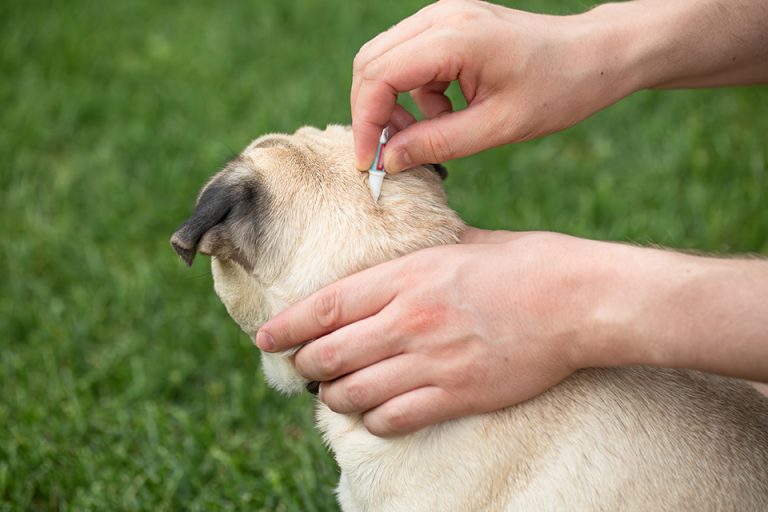
Experts in Flea Pest Control in MissourI
Treat for flea infestations
Fleas are small, wingless pests that enter your home, usually by attaching themselves to a pet dog or cat. However, this does not mean your pet is the only host they will attach themselves to for a meal. While they don’t have the ability to fly, they can jump long distances, attaching themselves to whatever host they land on. Since fleas are so small, they may not be noticeable at first.

FACTS ABOUT FLEAS
Here are some key facts to better identify the presence of fleas in your home:
- Estimated 2,500 species of fleas in the world, 325 in the U.S. The most common is the Cat Flea.
- Fleas are wingless, dark-reddish brown, about 1/8 inches in length and oval in shape
- Fleas can jump 7 feet vertically and 13 feet horizontally
- Fleas have a 4-stage life cycle: egg, larvae, pupa, and adult. Under normal conditions, it takes 3-6 weeks to go from egg to adult
- Adult fleas prefer to feed every 2-3 days and must feed before laying eggs
- Female fleas begin to produce eggs within 24-48 hours of its first blood meal
- Eggs are laid in batches of 20 and can be laid daily. Female fleas will lay eggs continuously until they die.
- 1 female flea can lay up to 5,000 eggs in a lifetime
- Total flea infestation is comprised of 5% adults and 95% pre-adults
- The average lifespan of adult fleas is usually 4-6 weeks when a host is available
- Pre-adult fleas can live up to 1 year (adults 2-3 years) if a host is not available.
Where Do Fleas Come From?
- Wildlife (squirrels, raccoons, groundhogs, opossums, deer, birds, rodents, etc.)
- Neighboring pets
- Outside on your lawn
Signs of Fleas - What to Look For
- Inspect your pets – look for small insects crawling in their fur around the neck, face, and underside
- Examine your skin for flea bites
- Look for pepper-like droppings in pet bedding and other areas where pets rest or spend time
- While walking around with white socks, look for fleas “hitching a ride”
Flea Prevention Tips
To better protect yourself from these bloodsuckers, a proactive approach is advised.
- Treat your pets regularly with a proven quality product monthly from March - December
- Vacuuming regularly, including in cracks and crevices
- Wash pet bedding regularly
- Treat your lawn regularly
- Keep your lawn and landscaping well-maintained
- Regularly inspect pet bedding and resting areas such as beds, furniture, rugs, etc.
Flea Elimination Service Performed by Steve’s Pest Control in Missouri
Both an adulticide and an insect growth regulator (IGR) will be thoroughly applied to the interior. Exterior ground treatments are available if needed to address an infestation in the lawn and landscaping. Adulticide materials kill larvae and adult stages while the IGR will prevent eggs and larvae stages from further development. Adulticide materials have a residual life of 4-5 weeks and the IGR’s 7 months once applied. Interior preparation is required before our flea control treatment as well as arrangements made to treat all pets. Re-treatments may be necessary within 15-30 days of the initial application to establish complete elimination. A pre-project checklist, as well as a full explanation of all preparation procedures, will be provided before treatment.
FAQs
Common Questions about Ant Pest Control
What are fleas, and why are they a common household pest?
Fleas are small, parasitic insects feeding on the blood of animals and humans. Their rapid reproduction rate makes them common household pests, often causing discomfort for pets and family members.
How can I tell if I have a flea infestation in my home?
Indications of a flea infestation include pets and humans experiencing itching and bites, visible fleas on pets or in living spaces, and small, dark fecal spots on pet bedding or carpets.
Are fleas harmful, and can they transmit diseases?
What are some preventive measures to avoid flea infestations in my home?
To prevent flea infestations, regularly groom and treat pets for fleas, vacuum frequently, and maintain a clean, clutter-free home environment.
What methods do pest control services use to eliminate fleas in residential settings?
Pest control for fleas involves a combination of treatments, including targeted insecticides, growth regulators, and thorough vacuuming, addressing fleas in all stages of their lifecycle.
How long does it typically take to get rid of a flea infestation in a home?
The time required to fully eradicate a flea infestation varies but generally spans several weeks, ensuring all life stages of the fleas are effectively eliminated.
Are the pesticides used in pest control for fleas safe for pets and humans?
Pest control experts use approved, safe pesticides. However, it is essential to adhere to safety guidelines and keep pets and children away from treated areas during and post-treatment.
Can I use over-the-counter pest control products or should I hire a professional for flea control?
While over-the-counter products may offer some relief, professional pest control is typically more effective, especially for severe or persistent flea infestations.
What steps can I take to prevent future flea infestations after treatment? How to kill fleas in the home?
To prevent future infestations, regularly treat and groom pets, maintain cleanliness, use flea prevention products, and treat upholstery and carpets where fleas may reside.
Are there any specific types of fleas commonly found in residential settings, and how do they differ in behavior and appearance?
The most prevalent flea in homes is the cat flea, which can infest both cats and dogs. Pest control professionals can identify flea species and customize treatment plans to effectively target them.

